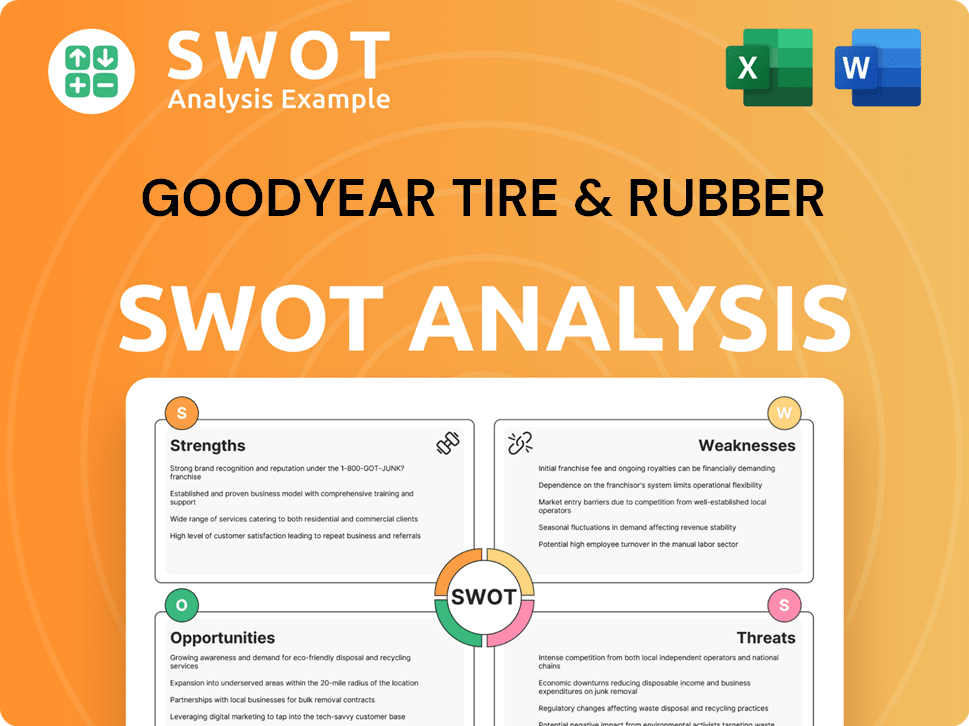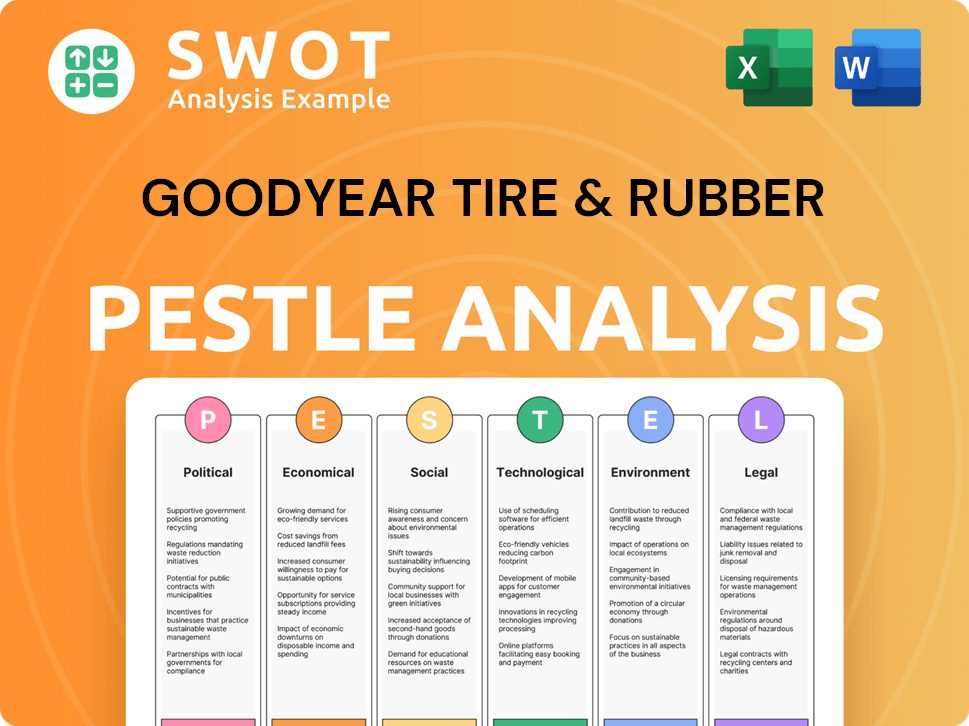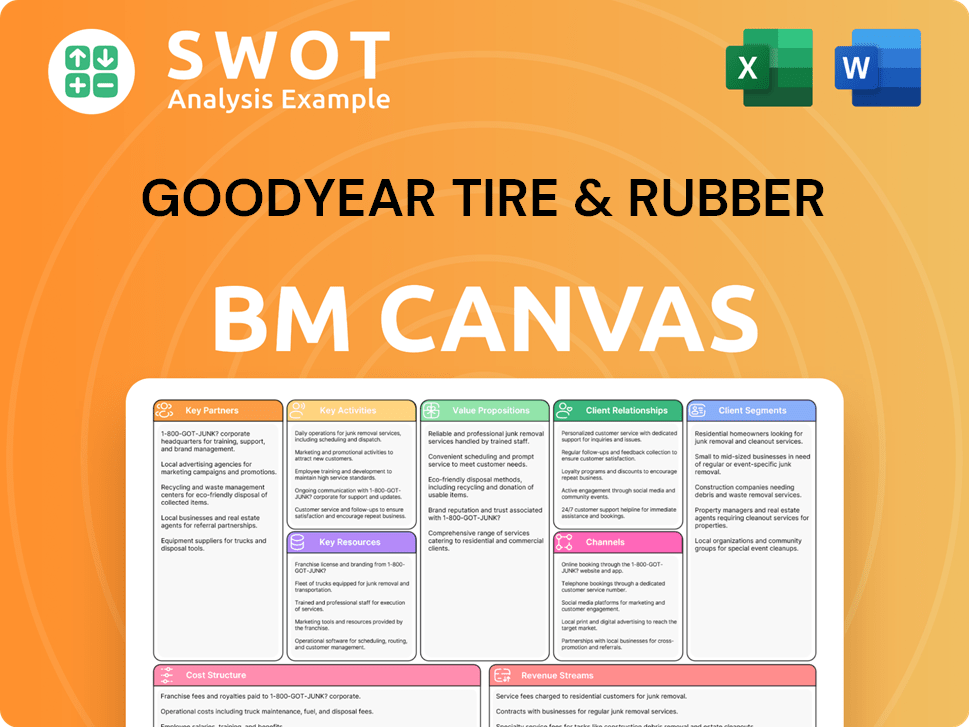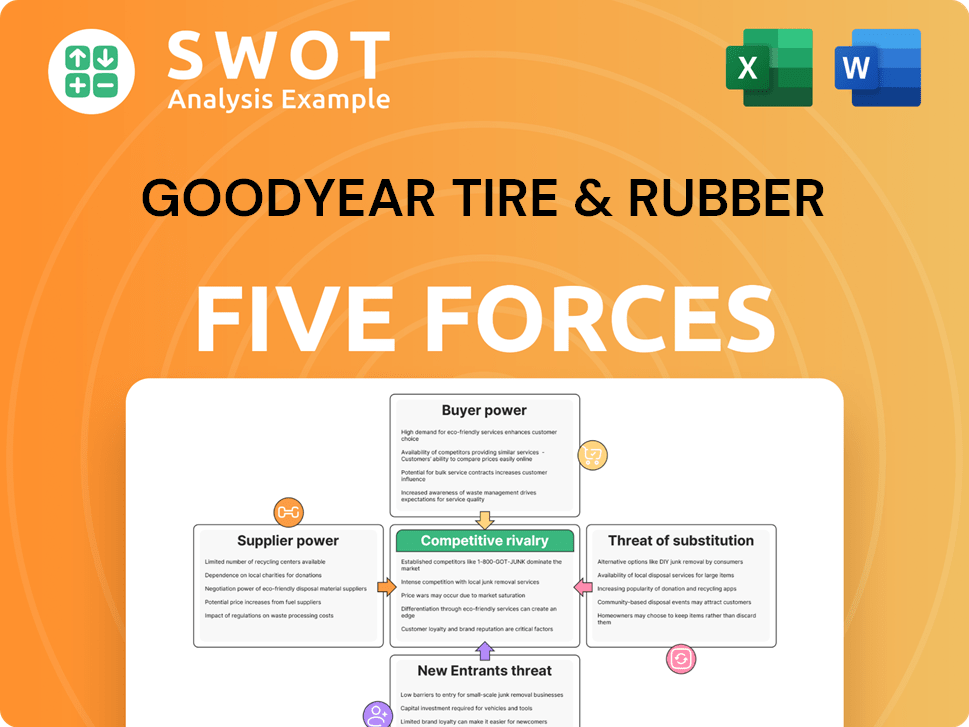Goodyear Tire & Rubber Bundle
How Did Goodyear Tire & Rubber Company Revolutionize Transportation?
Journey back in time to uncover the fascinating Goodyear Tire & Rubber SWOT Analysis, a story of innovation and resilience that transformed the automobile industry. From its inception in 1898 in Akron, Ohio, the Goodyear Rubber Company has been at the forefront of tire manufacturing, shaping the way we travel. Discover how this company's pioneering spirit and relentless pursuit of excellence have made it a global icon.

The Goodyear history is a compelling narrative of strategic adaptation and market dominance. Understanding the early Goodyear tire manufacturing and the company timeline reveals the key decisions that propelled it to the top. This exploration will uncover not only the challenges faced but also the pivotal moments that solidified Goodyear's legacy within the automobile industry and beyond, making it a cornerstone of modern transportation.
What is the Goodyear Tire & Rubber Founding Story?
The Goodyear Tire & Rubber Company's story began on August 29, 1898. Frank Seiberling, a man with manufacturing experience, saw a chance to capitalize on the growing need for rubber products. He aimed to create more dependable rubber goods for a rapidly industrializing world.
Seiberling's initial plan centered on making bicycle and carriage tires, horseshoe pads, and even poker chips. He got his starting funds, a $3,500 loan, from his brother-in-law. The name 'Goodyear' paid tribute to Charles Goodyear, who discovered vulcanized rubber, even though Charles Goodyear wasn't directly involved in the company's start. This choice showed respect for the groundbreaking rubber technology.
The company's beginnings were shaped by the late 1800s. This period saw the rise of mass production, the popularity of bicycles, and the early days of the automobile industry. These factors created a perfect environment for rubber product makers.
Frank Seiberling launched the Goodyear Tire & Rubber Company in 1898, focusing on bicycle and carriage tires.
- The company's name honored Charles Goodyear, the inventor of vulcanized rubber.
- Initial funding came from a $3,500 loan.
- The company was based in Akron, Ohio, which later became a hub for tire manufacturing.
- The early business model targeted the growing bicycle craze and the emerging automobile industry.
The Competitors Landscape of Goodyear Tire & Rubber shows how the company has grown and adapted over time. The early focus was on bicycle and carriage tires, but the introduction of the automobile industry quickly changed the market. By the early 1900s, the company was already making tires for cars, a move that would define its future. By 1910, Goodyear was a major player in the tire industry, demonstrating its quick adaptation to market changes. In 2024, the company continues to be a significant global player.
In the early 1900s, the automobile industry was booming, and Goodyear was ready. By 1916, the company was the largest tire maker in the United States, a testament to its foresight and ability to meet the needs of the growing automotive market. The company's expansion was rapid, with plants opening in various locations to meet the growing demand. This growth was fueled by innovations in tire design and manufacturing, solidifying its position in the industry. By the end of 2024, the company's global presence is still significant.
Goodyear's early success was also due to its marketing and branding efforts. The company invested in advertising and built a strong brand identity. The iconic blimp, introduced in 1919, became a symbol of the brand and helped enhance its visibility. This blimp continues to be a recognizable symbol. In 2024, the company's advertising campaigns remain a key part of its strategy.
Goodyear Tire & Rubber SWOT Analysis
- Complete SWOT Breakdown
- Fully Customizable
- Editable in Excel & Word
- Professional Formatting
- Investor-Ready Format

What Drove the Early Growth of Goodyear Tire & Rubber?
The early years of the Goodyear Rubber Company saw rapid expansion and diversification. From its founding, the company quickly moved beyond initial product offerings, recognizing the potential of the burgeoning automobile industry. This strategic shift was critical, allowing the company to capitalize on the rapid growth of car ownership and establish itself as a key player.
By 1901, Goodyear Tire began manufacturing automobile tires, a pivotal move. Early major clients included pioneering automobile manufacturers, and the company's reputation for quality grew quickly. This early focus on the automobile industry set the stage for future growth and innovation in tire manufacturing.
Goodyear's initial team expanded steadily to meet increasing production demands. The company's first facilities were located in Akron, Ohio, which became a hub for rubber manufacturing. The development of the straight-side tire in 1903 was a significant innovation, improving market reception.
By 1908, Goodyear was supplying tires for Henry Ford's Model T, a testament to its growing influence and production capabilities. The company also began its international expansion relatively early, establishing a presence in Canada by 1910. This expansion was crucial for capturing a larger share of the growing global market.
Throughout this period, leadership transitions occurred as the company scaled, with a strong emphasis on engineering and product development. This early growth was characterized by a focus on innovation, strategic partnerships, and a proactive approach to market opportunities, laying the groundwork for its future global leadership. The company's ability to adapt and innovate was key to its early success.
Goodyear Tire & Rubber PESTLE Analysis
- Covers All 6 PESTLE Categories
- No Research Needed – Save Hours of Work
- Built by Experts, Trusted by Consultants
- Instant Download, Ready to Use
- 100% Editable, Fully Customizable

What are the key Milestones in Goodyear Tire & Rubber history?
The Goodyear Tire & Rubber Company has a rich history marked by significant milestones, innovations, and challenges that have shaped its trajectory in the tire manufacturing and automobile industry. The company's journey is a testament to its adaptability and resilience, reflecting its evolution from its founding to its current position in the global market. The Goodyear history is a story of continuous adaptation and innovation.
| Year | Milestone |
|---|---|
| 1898 | Goodyear Rubber Company was founded by Frank Seiberling in Akron, Ohio. |
| 1909 | Introduced the first pneumatic airplane tire, a pioneering advancement for the aviation industry. |
| 1913 | Developed the all-weather tread, improving traction and durability. |
| 1910s-1920s | Secured patents for tire technologies, including the detachable rim, showcasing its commitment to R&D. |
| 1920s | Major partnerships with leading automotive manufacturers propelled its growth within the automobile industry. |
| 1940s | Shifted a significant portion of its production to support the war effort, manufacturing aircraft and other essential rubber products during World War II. |
| Late 20th Century | Pioneered the development and adoption of radial tires, revolutionizing tire design and performance. |
| 2023 | Goodyear Tire & Rubber Company reported net sales of $19.9 billion. |
Goodyear Tire & Rubber Company has consistently been at the forefront of tire technology. The company's innovations have not only enhanced tire performance but also contributed significantly to the advancement of the automobile industry.
In 1909, Goodyear introduced the first pneumatic airplane tire, a groundbreaking innovation for the aviation industry. This advancement significantly improved the safety and performance of early aircraft.
Developed in 1913, the all-weather tread design offered improved traction and durability, enhancing the driving experience. This innovation set a new standard for tire performance in various weather conditions.
Patents for the detachable rim technology demonstrated Goodyear's commitment to research and development. This innovation made tire changes easier and more efficient.
During World War II, Goodyear played a crucial role in developing synthetic rubber, crucial for the war effort. This innovation helped overcome natural rubber shortages.
Goodyear was a key player in the adoption of radial tire technology, which significantly improved tire performance and fuel efficiency. This innovation revolutionized the tire manufacturing industry.
Goodyear continues to innovate with run-flat tires, which allow drivers to continue driving for a limited distance after a puncture. This technology enhances safety and convenience.
Goodyear has faced numerous challenges throughout its history, requiring strategic adaptations to remain competitive. These experiences have shaped its approach to innovation and market dynamics.
The Great Depression in the 1930s significantly impacted Goodyear's sales and production. The company had to navigate a severe market downturn and adjust its operations.
Goodyear faced competition from other emerging tire manufacturers, requiring continuous product improvement and market diversification. The company consistently innovated to stay ahead.
During World War II, Goodyear shifted a significant portion of its production to support the war effort, which required substantial adaptation. The company manufactured essential rubber products and aircraft components.
After World War II, Goodyear faced the challenge of re-adapting to civilian production and intense global competition. This transition required strategic adjustments to meet changing market demands.
The radial tire revolution in the latter half of the 20th century posed a significant challenge, requiring substantial investment in new manufacturing processes and designs. Goodyear adapted to remain competitive.
Goodyear has had to navigate economic downturns and shifts in consumer demand. The company has consistently adapted its strategies to maintain its market position.
Goodyear Tire & Rubber Business Model Canvas
- Complete 9-Block Business Model Canvas
- Effortlessly Communicate Your Business Strategy
- Investor-Ready BMC Format
- 100% Editable and Customizable
- Clear and Structured Layout

What is the Timeline of Key Events for Goodyear Tire & Rubber?
The Goodyear Tire & Rubber Company has a rich history marked by significant milestones in the tire manufacturing industry. Founded in 1898 in Akron, Ohio, the company quickly became a key player in the automobile industry. From pioneering tire innovations to navigating economic challenges and global conflicts, Goodyear's history reflects its adaptability and enduring impact.
| Year | Key Event |
|---|---|
| 1898 | The Goodyear Tire & Rubber Company is founded in Akron, Ohio. |
| 1901 | Begins manufacturing automobile tires. |
| 1903 | Introduces the straight-side tire. |
| 1909 | Develops the first pneumatic airplane tire. |
| 1913 | Introduces the all-weather tread. |
| 1926 | Becomes the world's largest rubber company. |
| 1930s | Navigates challenges during the Great Depression. |
| 1940s | Contributes significantly to the World War II effort. |
| 1960s-1970s | Adapts to the rise of radial tires. |
| 1999 | Acquires Dunlop's tire businesses in Europe and North America. |
| 2021 | Completes the acquisition of Cooper Tire & Rubber Company, expanding its product portfolio and global reach. |
| 2024 | Goodyear focuses on sustainable materials and intelligent tire technologies. |
| 2025 | Expected to continue investing in advanced mobility solutions and fleet management services. |
Goodyear is actively investing in sustainable materials. The company is working to increase the use of renewable and recycled materials in its tires, aiming to reduce its environmental footprint. This includes exploring options like natural rubber sourced from sustainable plantations and the use of recycled polymers.
The company is developing intelligent tires equipped with sensors. These tires provide real-time data on pressure, temperature, and wear, enhancing performance and safety. This technology is crucial for fleet management and autonomous vehicle applications, offering valuable insights for optimized tire maintenance and vehicle operation.
Goodyear is expanding its presence in the electric vehicle (EV) market. They are developing tires specifically designed for EVs, focusing on features like lower rolling resistance to improve range and higher load capacity to support the heavier weight of EVs. This strategic move aligns with the growing demand for EV-specific tires.
Goodyear is leveraging data and connectivity to offer comprehensive mobility solutions. This includes services for fleets and autonomous vehicles, going beyond traditional tire manufacturing. These services provide data-driven insights for efficient fleet operations, predictive maintenance, and optimized vehicle performance, representing a shift towards a more integrated approach.
Goodyear Tire & Rubber Porter's Five Forces Analysis
- Covers All 5 Competitive Forces in Detail
- Structured for Consultants, Students, and Founders
- 100% Editable in Microsoft Word & Excel
- Instant Digital Download – Use Immediately
- Compatible with Mac & PC – Fully Unlocked

Related Blogs
- What is Competitive Landscape of Goodyear Tire & Rubber Company?
- What is Growth Strategy and Future Prospects of Goodyear Tire & Rubber Company?
- How Does Goodyear Tire & Rubber Company Work?
- What is Sales and Marketing Strategy of Goodyear Tire & Rubber Company?
- What is Brief History of Goodyear Tire & Rubber Company?
- Who Owns Goodyear Tire & Rubber Company?
- What is Customer Demographics and Target Market of Goodyear Tire & Rubber Company?
Disclaimer
All information, articles, and product details provided on this website are for general informational and educational purposes only. We do not claim any ownership over, nor do we intend to infringe upon, any trademarks, copyrights, logos, brand names, or other intellectual property mentioned or depicted on this site. Such intellectual property remains the property of its respective owners, and any references here are made solely for identification or informational purposes, without implying any affiliation, endorsement, or partnership.
We make no representations or warranties, express or implied, regarding the accuracy, completeness, or suitability of any content or products presented. Nothing on this website should be construed as legal, tax, investment, financial, medical, or other professional advice. In addition, no part of this site—including articles or product references—constitutes a solicitation, recommendation, endorsement, advertisement, or offer to buy or sell any securities, franchises, or other financial instruments, particularly in jurisdictions where such activity would be unlawful.
All content is of a general nature and may not address the specific circumstances of any individual or entity. It is not a substitute for professional advice or services. Any actions you take based on the information provided here are strictly at your own risk. You accept full responsibility for any decisions or outcomes arising from your use of this website and agree to release us from any liability in connection with your use of, or reliance upon, the content or products found herein.